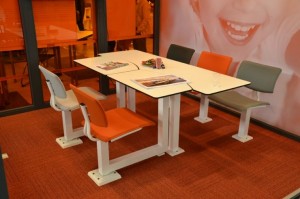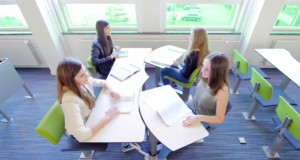New Revolving Furniture for Mixed Practices and Interactive Classes
Since the last decade interactive classes and flipped classroom pedagogies came into higher education. These pedagogies prefer convertible settings, i.e. frontal instruction and group work within a single space. Easy change of tables and seats and especially preventing messy arrangements in the classroom were challenges for an industrial design master assignment.
A first prototype was designed in 2010 by master student Timo van de Kreke in cooperation with manufacturer EromesMarko in the Netherlands. Two years later the prototype was converted into a null series with two possible models for further evaluation. Meanwhile several improvements have been made for the 2014 production series. Developments are described in more detail in this paper.







2 comments
I am a professor here in the Philippines and starting to write a research on classroom furniture. In your paper it did not consider the cost and the space. You are correct in stating that the strategy of most universities are massification. I have not read any update on the paper presented.
This article gives, in a way, a mind baffling insight into occupation and educational use of classrooms. Why has no one before stumbled upon this issue? 49% occupancy of halls and of these halls only 32% chair occupancy! It raises the question though:”Where is everybody”?. I presume that the number of halls/seats is derived from the number of students and or courses. The discrepancy deserves further investigation.
Beforehand I had not seen the possibilities and utilisation of changing the configuration within a single lesson. I feel that the flipped classroom gets to a new dimension; 15 minutes of instruction and then reconfiguration for group assignments. The lecturer then can change easily back to instruction if he discovers that several groups run in to the same problem. This is a big advantage for curricula which utilise the flipped classroom concept.
All technical improvements have already been adapted in the design. The most important technical improvements are the ones concerning accuracy and tolerance. Due to the swing arm concept is even the slightest imperfection in the floor/foundation a challenge for the alignment of the tables. We have tackled this successfully and have installed this new version in various other projects.
As a representative of EromesMarko I am very proud that we were able to work on this ground breaking project with the TU Delft. Our combined knowledge of education and furniture have led to this successful concept. We will follow the findings of this project closely to further develop this concept.